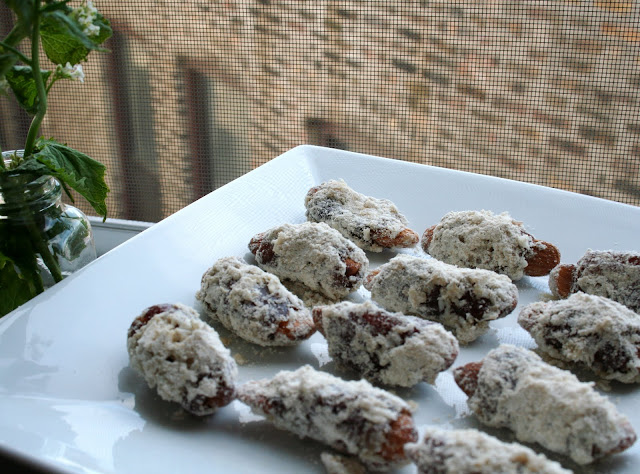I decided to make my own powdered sugar for the frosting, which was a bit more grainy than most people might like; still, an easy fix. I used (sustainable) palm oil (aka veg shortening) instead of coconut oil, because of another friends allergies. IF YOU CAN, USE UNREFINED COCONUT OIL. Sorry to yell, I just can't emphasize the importance of good coconut oil enough (like Nutiva.) Make sure you get unrefined, as regular has no flavor.
I modified a general cupcake recipe to make this, and added a few things myself, but drew the spice amounts from including Jo Ann Sugimoto from the "Just a Pinch" Recipe Club's blog:
1 c. WW Flour
1 c. Unbleached Flour (or 2c. total WW - I do this; it works for a heavier cake)
1 1/2 t. Baking Soda
1/4 t. Real Salt
6 T. Unrefined Coconut Oil
3/4-1 c. Natural Sugar, mixed with 1/2 t. Blackstrap Molasses (a good source of iron)
2 t. Cinnamon
1/2 t. Cloves
1/4 t. Black Pepper
1 1/2 t. Potato Starch or Energy Egg Replacer mixed w/ 2T Warm Water
1 T Flax, Ground
3/4 C. Almond milk
1t. Apple Cider Vinegar
Preheat oven to 350. Sift dry ingredients. Cream vanilla, coconut oil, and sugars. Add "egg," or potato starch. Then add almond milk and flour dry mixture in 1/4 c. increments, intermittently. Pour into cupcake molds 3/4 full.
Sprinkle natural brown sugar on top of the cakes, concentrating on the edges; it will crystallize and make a nice crispy crust. Bake 17-22 minutes.
I tried my hand at making caramel and pouring it on top of the cakes before frosting... but the caramel was a disaster! So obviously I won't share the recipe for that. If you can make a good caramel sauce, try it!
A simple coconut oil/ powdered sugar frosting will work well for this. If grinding your own powdered sugar, add a pinch of egg replacer, corn starch, or potato starch.
Coconut Snow Dates are easy to make: mix 1/4 cup oat flour (or ground oats) with 1/4 cup shredded coconut. Stuff dates with whole almonds, coat with a thin layer of raw almond butter, then roll in oat/ coconut mixture. I think rolled dates are usually cooked in butter before being dipped in the oat/ coconut mixture.
The only issue that I have is with the flour mixture remaining stuck to the dates. Any suggestions would be appreciated!
The only issue that I have is with the flour mixture remaining stuck to the dates. Any suggestions would be appreciated!












